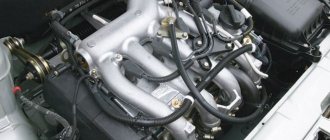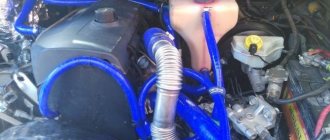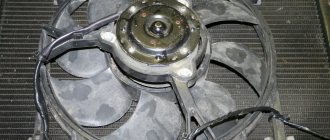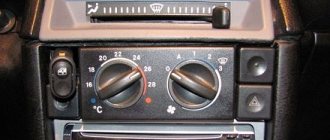August 28, 2019 Lada.Online 16 292 0
During vehicle operation, problems may arise in the operation of the cooling system, which leads to engine overheating. If you allow the coolant to boil, you may end up with expensive engine repairs. The following instructions tell you how to avoid this unpleasant moment.
The vehicle's instrument cluster is equipped with a coolant overheat indicator in the engine cooling system. If the warning light comes on and the temperature gauge needle approaches the red zone of the scale, then the engine is overheating. Most often this happens in city traffic jams or in difficult driving conditions, for example, when slipping. Under these conditions, a completely serviceable engine can overheat, especially if the radiator honeycombs of the cooling system are clogged with dirt.
Note
. If the overheating warning light comes on immediately after starting a cold engine, and the engine management system malfunction warning light comes on at the same time, the coolant temperature sensor is most likely faulty. In this case, diagnose the control system.
If the overheating warning light comes on while driving at low speed and high engine load
(on a long climb, when slipping, etc.), but clouds of steam are not yet escaping from under the hood, stop as soon as possible without turning off the engine. Try turning on the interior heater at full power. Perhaps the engine can be cooled a little. This will avoid thermal shock after stopping the engine - boiling of the coolant at the points of its contact with the most heat-stressed parts.
If, after turning on the heater, the overheating indicator goes out, you can continue driving, avoiding increased load on the engine. But if the indicator continues to light for 2-3 minutes while the heater is running, and also if steam appears from under the hood, the engine must be stopped.
If the overheating warning light comes on in the traffic jam
When the engine has been idling for a long time, or when driving in normal mode, the engine must be stopped as quickly as possible. Turn on your hazard lights and try to pull over to the side of the road. If you can’t do this in a traffic jam on a multi-lane road, you will have to stop in your lane.
How the engine is cooled
The vast majority of internal combustion engines are liquid-cooled; there are, of course, air-cooled ones, but this happens more often in light scooters and low-power motorcycles. All other engines are cooled with liquid: antifreeze, antifreeze. Some people use plain water, but it is significantly inferior in efficiency to specialized liquids. In addition, ordinary water does not have the best effect on the condition of the metal surfaces of the system; they oxidize and rust. Moreover, in winter, the water freezes and can damage the engine.
The coolant permeates the entire engine block through special shallow tunnels, preventing it from exceeding the maximum temperature. By constantly circulating, they remove excess heat, keeping the heat within 90. If the circulation is not enough, the system starts a fan, which additionally blows on the radiator. It turns off automatically when the coolant temperature does not return below 90 degrees. This is an example of the ideal operation of the system, but sometimes failures occur, the reasons for which we will analyze.
Causes of engine overheating
Why do they get hotter?
In addition to the fact that the modern engine itself heats up more, it now has neighbors that further heat up the situation. For example, catalytic converters, which on most modern cars are located in close proximity to the engine.
Air conditioner
also contributes to an increase in temperature: its capacitor not only generates heat, but also impedes the passage of air to the engine radiator. In addition, dirt (fluff, leaves) inevitably accumulates between these heat exchangers, preventing normal cooling. In addition, in order to reduce the overall weight, the radiators became thin, and the antifreeze filling volumes were almost halved - in normal mode the cooling system works normally, but there is practically no emergency reserve.
Automatic transmission
- another heat source that contributes to an increase in temperature under the hood.
Turbocharging
also increases the temperature. Moreover, if the engine is equipped with intercoolers, which also heat the engine compartment.
This is interesting: Cleaning the crankcase ventilation system of VAZ 11183, VAZ 21116 and VAZ 11186 Lada Granta engines
Causes of overheating
In fact, there can be many reasons leading to engine overheating; let’s try to list the most common:
- Filled with plain water. This option is not very suitable for a cooling system, because water closer to 100 degrees already begins to boil and quickly evaporate. In addition, metal tubes do not really like water; it causes oxidation and corrosion. And from this, efficiency quickly drops, even with a sufficient level of liquid.
- Insufficient coolant level in the system. Antifreeze also contains water, and it tends to evaporate, causing the level to drop over time. If there is insufficient fluid, the engine may overheat. Definitely need to replenish.
- The radiator or pipes are leaking, there is not enough fluid, which causes overheating.
- The fan sensor is faulty. The thermostat controls the fluid temperature, and when it rises above 95, it turns on additional cooling. If the sensor does not detect heating, then without a fan the engine will quickly overheat.
- The pump does not pump. The coolant circulates inside the engine block using a pump; this device drives the liquid around the entire perimeter. If the pump malfunctions, the antifreeze does not move anywhere and cannot remove heat.
- The cooling system is clogged. It happens, although quite rarely, that foreign inclusions get into the cooling system, which prevent the free circulation of liquid. It could be the hoses themselves, which peel off over time and pieces of them end up in the antifreeze.
Signs and causes of malfunctions of ODS Grants
There are not many elements involved in the cooling system, and therefore the list of faults is small. Signs of ODS problems:
- The engine gets very hot. Since the coolant temperature indicator on the Lada Grant was removed to reduce the cost, the driver will be able to track the temperature increase only after reaching a critical point. In this case, the warning indicator on the instrument panel will light up. Overheating is indicated by constant operation of the electric fan. Another reason is the failure of the temperature sensor, which transmits inflated readings to the ECU. Systematic overheating of the engine can also be determined by white carbon deposits on the spark plugs.
- The engine cannot warm up or takes a long time to warm up. In this case, the stove will blow cool air, the radiator pipe from below will be warm, but not as the engine warms up, but almost immediately after starting. A faulty thermostat is to blame. If the engine is in a constant state of insufficient heating, operation for a long time is prohibited, since it cannot be subjected to loads.
- Antifreeze leak. The problem can be determined by inspecting the elements of the ODS. On a hot engine, you can see fumes from antifreeze, and traces of coolant will also be visible under the engine. The most dangerous internal leak occurs when antifreeze enters the combustion chambers. Visually there are no leaks on the engine, but the coolant level in the tank is still decreasing.
Another characteristic sign of ODS problems is an increase in the oil level and white smoke from the exhaust pipe. This situation is dangerous due to the complete failure of the internal combustion engine, since the entry of antifreeze into the cylinders deprives the elements of the lubrication system.
Motor oil mixed with coolant completely loses its properties. Operating a vehicle with such a malfunction is prohibited.
Engine repair will be required, as the problem is related to a broken cylinder head gasket, a damaged water jacket, or a crack in the block.
The most common reasons are:
- natural wear and tear of parts;
- mechanical damage;
- violation by the owner of engine operation requirements.
The use of low-quality antifreeze, mixing different types of coolant, and installation of low-quality parts are also causes of malfunctions of the elements of the power plant cooling system. Repairs carried out without the appropriate knowledge, skills and experience lead to breakdowns. SOD problems require an early solution, as they affect the resource of the power plant.
No less dangerous are hidden problems, for example, engine detonation caused by overheating. Clogged radiator honeycombs prevent normal cooling, and the antifreeze temperature does not have time to decrease, causing the engine to overheat. Fuel detonates in the combustion chambers, the cylinder head gasket burns out, the plane of the cylinder head is disrupted, and the engine subsequently “jams”—there is a need for major repairs or replacement. The cooling system requires constant monitoring - you need to monitor the level of antifreeze in the expansion tank and periodically change the working fluid.
A pump malfunction is characterized by coolant leaks at the pump installation location, disruption or cessation of antifreeze circulation through the system. In this case, the engine overheats, but jamming of the pump bearing is even more dangerous, since on the Grant this leads to a broken timing belt and damage to the valves. Engine repair will be required. Malfunctions of the electric fan in most cases are associated with a violation in the electrical circuit, malfunctions of the thermal relay and the electric motor. Lack of forced cooling of the motor by a fan leads to overheating.
The most unpleasant malfunction for car owners is damage to the cylinder head gasket or a defect in the surface of the head at the point of contact with the cylinder block. Cracks in the cylinder head and cylinder head are less common. This causes coolant to leak into the oil sump. The tightness of the cooling system is also compromised if there are problems with the connecting pipes - cracks, blockages and loose connections.
Failures of the SOD can also include electronic malfunctions. In the case of Granta, this is a malfunction of the warning light warning of overheating and failure of the engine temperature sensor. As a result, the electric fan does not turn on at the right time, and the engine temperature exceeds critical values - overheating occurs.
Return to contents
What to do
What to do if the engine overheats
As soon as you notice that the engine has begun to overheat and the sensor is already entering the red zone, the best option is to turn off the engine. If you are on the move, then you should turn on neutral and roll until you come to a complete stop (with the emergency lights on), no loads, do not touch the gas pedal.
If the fluid level is fine, then there is a failure of the fan, thermostat, or something has gotten into the system. You can open the entire perimeter, that is, turn on the stove for maximum heating of the interior. The fluid temperature should drop, after which we calmly turn off the car.
If there is almost no fluid at all, you just noticed, then there is no option, turn off the engine immediately. This is a case of damage to the engine, either the oil drain or the radiator. The car will only be transported to service via a tow truck.
What the professionals advise is to keep an eye on your car and check the coolant level. If the antifreeze is normal, then even the failure of the fan will not be fatal; you can always help reduce the temperature with the stove.
Good afternoon. In today's article I will talk about the causes of engine overheating and consider ways to eliminate them. Traditionally for our site, the article contains a large number of photos and video materials.
How to fix breakdowns
Repair of ODS elements is not considered as part of troubleshooting. In most cases, replacement of failed parts is necessary.
Return to contents
Replacing the thermostat
Lada Granta is available with two types of engines: one of them is 8-valve, the other is 16-valve. The location of the thermostat on these power plants is somewhat different, which means that replacement is carried out with certain differences.
To replace the thermostat on an eight-valve engine, you will need a small set of tools: socket wrenches, screwdrivers, a Torex wrench and a container for draining the coolant.
The replacement procedure is simple; to do this, you need to follow a number of steps:
- Place the car on a level surface and use a jack to raise the front end.
- After unscrewing the bolts securing the engine protection, remove it.
- Place a suitable container under the plug to drain the coolant from the radiator.
- Unscrew the cap from the expansion tank neck.
- Unscrew the drain plug and wait until the liquid drains.
- Loosen the thermostat pipe clamp from the rear and disconnect the hose.
- Loosen the clamp on the front thermostat pipe and disconnect it.
- The ground wire is secured with a nut on the thermostat stud - unscrew it and disconnect the wire.
- Unscrew both nuts that secure the thermostat to the studs and remove it.
- Remove the O-ring and, unscrewing the three nuts, remove the thermostat cover.
- Press and rotate the locking plate to remove the cover.
- Remove the spring with the valve mechanism.
Installing a new thermostat is carried out in the reverse order. If the hoses will not be changed, then to prevent possible leakage of antifreeze, it is recommended to lubricate them from the inside with a small amount of sealant before installation.
After installing the thermostat, all pipes are tightened with new clamps, and coolant is poured into the expansion tank.
Then you need to start the engine and check the operation of the cooling system, if necessary, remove the air lock. To replace the thermostat on a 16-valve engine, the same set of tools is used, steps for an 8-valve engine are repeated from 1 to 6, then the process is as follows:
- Disconnect all pipes through which coolant is supplied to the thermostat by loosening the clamps.
- Unscrew the fastening bolts and remove the thermostat cover from the seat.
- Remove the sealing ring, turn the fixing plate by pressing and remove the spring with the valve mechanism.
Installation of a new thermostat is carried out in the reverse order. All hoses are connected, antifreeze is poured into the system, the engine is started, and if necessary, the air lock is removed, after which antifreeze is added to the tank to the mark between the minimum and maximum. There are many fakes and low-quality parts on the car parts market, so it is advisable to check the thermostat before installation. To do this, you need to heat water in a container to a temperature close to boiling and place a thermostat there; if the valve begins to open slightly, it means the device is working.
Replacing the thermostat can be done with your own hands in a regular garage. There are no difficulties, but you will have to spend money on a new part, pipes, if changed, and coolant. To save time, you can contact any car service center, where within 20-30 minutes the technicians will change the thermostat for 200-300 rubles.
Return to contents
Replacing the coolant pump
To replace the pump on a Grant you will need a set of sockets, wrenches and screwdrivers. Many car owners combine pump replacement with timing belt replacement. At the initial stage, the process is identical for both procedures:
- Disconnect the negative terminal from the battery.
- Using a 17 mm wrench, rotate the camshaft pulley by the fastening nut until the mark on the pulley matches the mark on the rear casing cover. So the piston in the first cylinder will be at top dead center.
- The nut securing the timing belt tensioner roller is unscrewed and the tension is weakened.
- Drain the coolant through the drain hole on the radiator.
- Unscrew the bolts securing the pump to the cylinder block and remove it together with the sealing gasket.
- The new pump must be installed with the number facing up, and it is recommended to replace the sealing gasket.
Next, installation of the belt and pulleys (if the timing belt has been changed) is carried out in the reverse order. In this case, you need to ensure that the marks are not knocked down, otherwise the valve timing will be disrupted.
A car service center will charge from 800 to 1,500 rubles for such work, depending on the type of engine (8 or 16 valves).
Return to contents
How to repair an expansion tank
During engine operation, the expansion tank is constantly deformed from increasing and decreasing pressure in the system, as well as from temperature changes. Over time, the material wears out, and at peak pressure, microcracks form on the walls. In most cases, no one repairs this part - the tank is replaced. But there are also those who try to repair it with their own hands. The material from which the tank is made is incompatible with most adhesive bases, so it will not be possible to seal it. For repairs, you can use two available methods:
- soldering with a soldering iron using metal reinforcing mesh;
- repair cracks with epoxy resin or cold welding.
Compositions based on epoxy resins and similar substances act temporarily, so for high-quality repairs it is recommended to solder the tank. The crack site is thoroughly cleaned with fine sandpaper, degreased and dried. A thin metal mesh is placed over the hole and a continuous layer is sealed into plastic with a soldering iron.
The treated area is cleaned, puttied and, if necessary, primed and painted. The car service center does not do such things and offers to replace a cracked tank - the cost of the service is no more than 200 rubles.
Connecting hoses, electric fans and radiators should be replaced if they fail. The latter can be soldered, but no one is responsible for the quality, since the process is labor-intensive and requires equipment and experience. Considering that soldering costs about 800 rubles, then it is more logical to purchase a new radiator.
Return to contents
The most common causes of engine overheating and how to eliminate them.
The radiator is clogged.
The radiator is the main component of the cooling system, which is designed to remove heat. It can be clogged both from the outside, in this case we have a separate article on cleaning it on our website, and from the inside.
An example of a radiator clogged with dirt from the outside:
Such a radiator can be blown out at a service center or washed at a car wash.
An example of a radiator clogged inside:
As a rule, radiators clog from the inside when driving on water, or when the cooling system malfunctions.
Cleaning the radiator is carried out after removing the radiator, by flushing it with a reverse flow or using special chemicals; we also have a separate article about this.
If it is impossible to flush the radiator from the inside, replace it.
The way to eliminate the problem is to blow out the radiator from the outside and flush it from the inside.
Is the absence of an engine temperature sensor a cost-saving measure?
An interesting point is the absence of an indicator on the instrument panel indicating the fluid temperature and engine condition. As the developers themselves say, this indicator does not correspond to the price category of the car and is too expensive for it.
The solution to the problem was to install a special light bulb on the panel, which lights up red in case of overheating. If the system is working properly, in this case, the fan automatically turns on, and the problem is resolved without driver intervention.
Despite everything, the Lada Granta, whose cooling system is very well thought out, works well and rarely causes breakdowns. This is a proven car, albeit of a budget class.
Our recommendations
It is easier to overheat the engine in extreme heat than in cold weather. Therefore, the higher the temperature outside
, the more carefully you need to handle the engine - avoid sudden acceleration and braking. Do not forget to brake the engine: combustion of the air-fuel mixture does not occur, and the coolant circulates more intensively through the system.
Remember about radiator cleanliness:
on some models it is justifiable to wash it at every maintenance. But usually it is enough to give him water treatments once every two to three years.
Complete coolant replacement
required at least once every 60,000–80,000 km. By this mileage, antifreeze usually begins to lose its properties. And its condition affects not only the temperature regime, but also the life of the main components of the cooling system.
Some auto component manufacturers produce thermostats with different opening temperatures. For example, for the popular 1.6‑liter Renault K4M engine there are thermostats at 82 degrees, and there are at 86. Four degrees is a significant difference. For cars with very intense thermal conditions (due to both design and operational reasons), it is better to choose a thermostat with a lower operating temperature.
And don't forget to service your car regularly
and troubleshoot problems that arise. Then you won’t have to croak on the road due to overheating and frantically search for the tow truck’s phone number.
Diagnostics of the LADA Granta engine cooling system
When operating a car, you can assess the technical condition of the cooling system by looking at the engine overheating warning lamp and the fluid level in the expansion tank. A decrease in coolant level is usually caused by a leak in the system. If the level drops to the MIN mark or the warning lamp lights up, there may be a malfunction in the cooling system.
| 1. Checking the coolant level in the expansion tank . It, which should be 25-30 mm above the MIN mark made on the body of the expansion tank. If the fluid level is at the MIN mark or below, add coolant to the reservoir. |
Warning
The coolant level should be checked on a cold engine. A slight increase or decrease in the coolant level during heating and cooling of the engine is not a malfunction. This is due to the thermal change in the volume of the liquid.
If you have to regularly add coolant, you should check the tightness of the cooling system.
2. Check the tightness of hoses and connections of the cooling system . Inspect the engine compartment and pay attention to the condition and tightness:
- Expansion tank hoses;
- Radiator steam exhaust hose;
- Radiator supply hose;
- Radiator outlet hose.
| We check the reliability of the connection of the hoses to the thermostat housing. You can try to eliminate coolant leakage from under the hoses by replacing the spring clamps with screw clamps. Do not overtighten the clamps, as they may cut the hoses. You can temporarily repair a broken cooling system hose using adhesive tape (silver reinforced adhesive tape is especially suitable). |
3. Checking the integrity of engine cooling system elements.
- Expansion tank housing;
- Engine radiator;
- Heater radiator;
- Thermostat housing;
- Connections between the coolant pump (pump) and the cylinder block. We also check that there is no leakage of liquid from the drainage hole of the pump (located at the bottom of the pump), indicating wear of its seal.
There should be no coolant leaks anywhere.
| 4. Checking the thermostat . We start the cold engine. We control the temperature and circulation of the coolant in the small and large circles by touch, by changes in the temperature of the hoses and pipes of the cooling system (in the photo the air filter has been removed for clarity). |
Comment
If the engine cooling system is working properly, then when the coolant temperature is less than 90 °C, the thermostat valve should be closed and the coolant should circulate in a small circle. As a result, the lower radiator hose and the radiator itself will be noticeably cooler than the thermostat housing, through which hot coolant circulates. When the coolant temperature reaches about 90 °C, the thermostat valve will open and a gradually increasing flow of hot liquid will begin to flow into the radiator. In this case, first the radiator and then its lower hose will begin to heat up.
We leave the engine running until the engine radiator fan operates. When the coolant temperature rises to a certain value, the electric fan should turn on, and when the temperature drops, it should automatically turn off. If the electric fan does not turn on in time, the liquid boils, it is necessary to check the serviceability of the fan electric motor or the serviceability of the engine control system.
Checking the radiator for leaks
The diagnostic process is not at all complicated; we carry it out ourselves, and if you don’t have free time, visit a service station to have the work performed by professionals.
Checking the radiator from the engine compartment side
- We place the car within the perimeter of the repair area, on the inspection hole, and open the hood.
- From the engine compartment side, we inspect the surface of the radiator for drips and traces of antifreeze (antifreeze) leakage.
- We carry out similar actions from under the bottom of the car;
- We inspect the antifreeze supply/return lines, upper and lower circuits.
The most common places for depressurization: corners around the perimeter, joints, ties with clamps.
How to drain antifreeze from the cooling system of a Lada Granta
- The hood is open, the car engine has cooled down to a safe temperature so as not to damage the skin.
- We unscrew 6 screws from under the bottom and remove the oil pan protection.
- Unscrew the drain plug in the lower circuit of the radiator.
- At the same time, unscrew the drain plug on the wall of the cylinder block. We substitute the container.
Unscrew the plastic drain plug of the radiator tank
Note to the driver!
The Lada Granta version has 8 valves. Place the container for testing below the ignition module, under the cylinder block (nut at “13”).
In the Lada Granta 16-valve, we first dismantle the starter, since it prevents free access to the plug. If you do not remove the starter, antifreeze will flood the part, temporarily rendering it unusable.
- After the liquid is completely drained from the water jacket, screw in the drain plugs. Fill in new antifreeze in a volume of 7.5 liters to about or 8.0 liters to the recommended average level.











